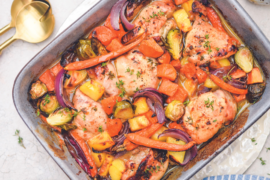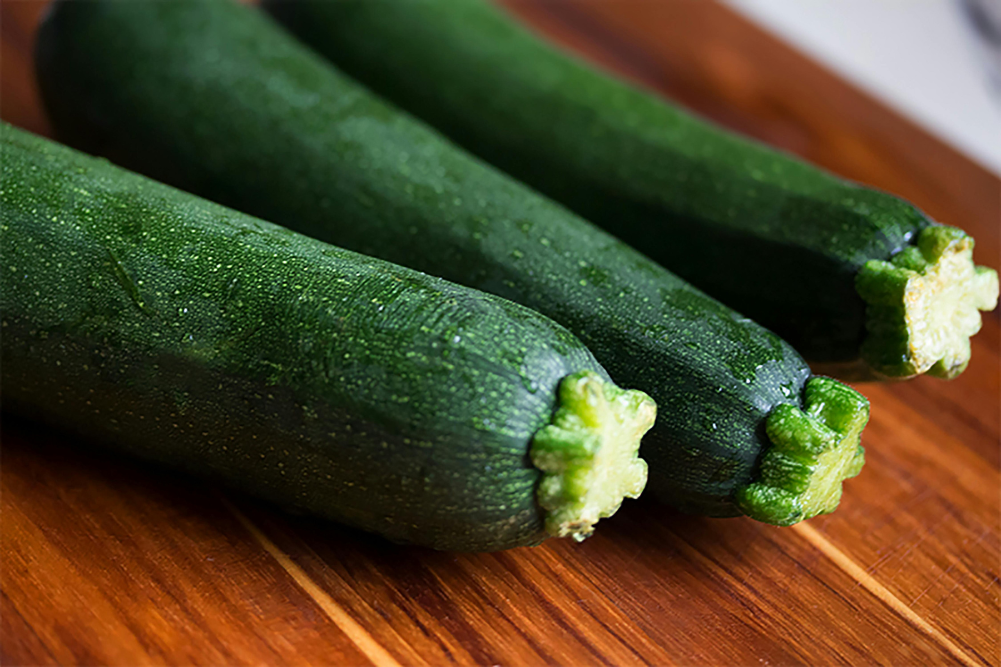All you need to know about these 4 healthy cooking oils
Cooking with oil is an everyday part of life, but not all oils are created equal. Different oils have different characteristics when it comes to cooking; some are better for sautéing and grilling, others thrive with high-heat cooking, while other oils are best reserved in the later stages of cooking such as drizzling or as a garnish. But how do we know which ones are most suitable for different dishes and culinary techniques?
Unfortunately, some oils can’t take the heat in the kitchen. One of the most important factors when considering which cooking oil to choose is the oil’s smoke point.
When cooking oils are heated, particularly at high heat, they eventually reach their “smoke point”. This is the temperature at which the oil starts to burn and is accompanied by smoke rising from the pan, which usually causes the dish or ingredients to taste burnt or bitter. When the oil reaches this smoke point it’s no longer stable and begins to break down, which can potentially cause it to oxidise and release harmful free radicals. In general, the more refined an oil is from its natural state the higher the smoke point is and the hotter it can get without breaking down. This usually makes them more suitable for high-heat cooking. Although most virgin or unrefined oils have a better depth of flavour and are better for you, they are much more volatile and less able to handle high-heat cooking.
When choosing a cooking oil, it’s also important to consider where the oil is from and how it has been processed. These factors can affect the overall performance of the oil considerably. Whenever possible, look for oils which have been minimally processed, especially when you’re not cooking at high heat. These oils tend to be richer in colour and have more of a cloudy look. Look for descriptions on the packaging like “virgin” or “cold-pressed”.
Virgin or extra-virgin means the oil has been minimally processed, without the use of chemicals. Cold-pressed means the oil has been extracted without using heat, which causes the nutrients to remain stable. These oils are called unrefined oils.
Whether you’re baking, barbecuing or making a delicious salad dressing, we look at four of the healthiest cooking oils and consider which ones are right for your needs.
Olive oil
Popular in the Mediterranean diet, olive oil is made from the juice of the olive tree fruit. Often referred to as the “gold standard” for cooking across the globe, it’s a very versatile oil in a wide range of dishes. Olive oil is also rich in antioxidants and heart-healthy fats which can help protect the cardiovascular system and decrease inflammation.
Olive oil is a great all-rounder cooking oil, but it’s recommended that different types are used for different cooking methods. The use of this oil largely depends on whether it is refined olive oil or extra-virgin olive oil (EVOO). EVOO is deeper in colour and more robust in flavour, but has a lower smoke point compared to olive oil. The flavour of EVOO largely depends on its place of origin — some oils are more subtle with a grassier flavour while others are richer, bolder and fruitier. The smoke point of EVOO is in the range of approximately 165°C to 190°C, while refined olive oil is up to 240°C depending on the level at which it has been processed.
EVOO is more suitable for lower-heat cooking like shallow frying, slow cooking (on low heat), salad dressings and searing. Although unrefined oils stand up to heat quite well, they tend to lose a bit of flavour in the process. EVOO is suitable for sweet dishes and desserts and is delicious in baked goods like olive oil cakes and muffins to make them moister. Just be careful which dishes you use it in, because it can have the tendency to overpower some dishes not requiring a robust olive oil flavour and make them too moist.
Lighter refined olive oils are ideal for medium- to high-heat cooking, but for uncooked dishes like salad dressings EVOO is more appropriate, since it can be used to add body and depth and to build flavour in a dish.
Avocado oil
Most of us love smashed avocados on toast, but what about avocado oil? Made from the flesh of pressed avocados, this oil is considered one of the healthiest cooking oils going around. With its mild, almost buttery flavour, avocado oil is a very versatile cooking oil since it has a neutral flavour base that doesn’t overpower other ingredients. Unrefined avocado oil is a pure oil that is extracted from the fruit and has a richer, buttery flavour and intense green colour, while refined avocado oil has been filtered, which results in a lighter yellow oil and less intense flavour.
On the nutrition side, avocado oil has a similar profile to olive oil. It is full of antioxidants and heart-healthy monounsaturated fats, which studies have shown may help lower blood pressure, LDL (bad) cholesterol and triglycerides. Almost 70 per cent of avocado oil consists of oleic acid, which is a very healthy monounsaturated fat. Since avocado has a higher smoke point than olive oil (an average of approximately 270°C), it is very versatile in cooking. This makes it suitable for high-heat cooking like deep-frying and barbecuing, as well as low-heat cooking like sautéing, roasting, searing and grilling. Try using avocado oil to marinate meats, roast vegetables, in bakes or smoothies and in salad dressings. The only limitation of avocado oil is its price point. Avocado oil is usually much more expensive than other oils, which often limits it as an everyday cooking oil for many people.
It’s important to look for a high-quality avocado oil with minimal processing and sustainable extraction techniques. Make sure to store avocado oil in a cool, dry place as there’s no need to refrigerate it.
Sesame oil
A staple in Asian cooking, sesame oil is a popular cooking oil which has become much more mainstream recently. Sesame oil is rich in heart-healthy antioxidants and unsaturated, monounsaturated and polyunsaturated fats. There are two main types of sesame oil: toasted and untoasted. Toasted sesame oil is deeper in colour and has a more amplified nutty flavour. This intense flavour makes it more suitable for the latter stages in cooking and finishing a dish or as a condiment for Asian dishes like potsticker dumplings or wontons. Since its flavour is quite intense, a little goes a long way! On the other hand, untoasted sesame oil has a lighter colour and relatively mild, warm toasty flavour so can be much more versatile for everyday cooking.
Refined sesame oil has a medium-high smoke point of up to 210°C, making it a versatile oil for a wide range of occasions including deep-frying, sautéing and grilling, especially lighter sesame oil which can be used as a substitute for other neutral oils like canola or vegetable oil. Toasted sesame oil is best reserved for low-heat cooking and dishes requiring a big flavour punch. Toasted sesame oil is best stored in the fridge when opened to extend its shelf life, since it tends to go rancid quickly.
Safflower oil
Safflower oil is made from the seeds of the safflower plant, native to places such as China, India, Iran and Egypt. Before it was known as a cooking oil, the orange flowers of the safflower plant were used as a dye for textiles as well as a saffron substitute. Although it is a lesser-known cooking oil it is beginning to increase in popularity. With its high smoke point (up to 265°C), and neutral flavour and aroma it works well as an everyday cooking oil for a wide range of cooking techniques, including deep-frying, grilling and stovetop cooking as well as options like salad dressings and sauces.
Two varieties of safflower oil are available: high-linoleic and high-oleic. High-linoleic safflower oil is rich in polyunsaturated fats and is best used for uncooked foods like salad dressings and dips. Due to its high polyunsaturated content, this oil is best kept refrigerated. In comparison, high-oleic safflower oil is high in monounsaturated fats and is best suited to higher-heat cooking since it has a higher smoke point. This oil remains liquid at cold temperatures so can be stored in the fridge to extend its shelf life.
Safflower oil is sold both chemically processed and cold-pressed like olive oil.
Oil storage tips
As well as using the right oil for the job, make sure to store your oil appropriately in a cool, dry place, out of direct sunlight. It’s best to buy oil in small quantities, so you are regularly replenishing and keeping it fresh since oils deteriorate and become stale over time. After a year, even the most premium extra-virgin olive oil probably should be avoided for raw applications, but still can be used for cooking.
Recipes
Honey and Mustard Chicken Tray Bake

Marinade
3 tbsp avocado oil
Juice 1 lemon
½ tbsp mustard powder
3 tbsp honey
2 garlic cloves, minced
6 chicken thighs
Traybake
2 red onions, cut into thick wedges
1 sweet potato, peeled & diced
2 potatoes, peeled & diced
1 carrot or 4 baby carrots
8 Brussels sprouts, halved
2 tbsp avocado oil
Salt & pepper, to season
2 tbsp fresh thyme, chopped
Method
Preheat oven to 200°C or 180°C fan-forced.
Place the marinade ingredients in a large bowl and whisk to combine. Add the chicken and mix well, ensuring the chicken is evenly coated. Cover and place in fridge for at least 15 mins.
Place the vegetables in a large baking tray and arrange in a single layer. Toss with avocado oil and season with salt and pepper. Roast for 30 mins.
Add the chicken to the pan and garnish with fresh thyme. Bake for another 30 mins until the chicken is cooked through and vegetables are tender.
Serve immediately.
Haloumi and Red Onion BBQ Skewers

250g haloumi, cubed
1 zucchini, sliced
1 red or yellow capsicum, deseeded & thickly sliced
1 red onion, cut into
wedges
Lemon Vinaigrette
3 tbsp safflower oil
1 garlic clove, minced
Juice 1 lemon
2 tsp Dijon mustard
1 tsp honey
Charred lemon slices, to serve
Place haloumi, zucchini, capsicum and red onion on skewers. If using wooden skewers, make sure the skewers are soaking in water prior to cooking, otherwise they may burn.
To make the lemon vinaigrette, place all the ingredients in a bowl and whisk well.
Preheat barbecue grill on medium heat.
Brush skewers with some of the lemon vinaigrette, making sure to coat each side. Cook the skewers for 4–5 mins until golden, making sure they are turned frequently so they are cooked evenly.
Serve the skewers immediately with the remaining sauce and charred lemon slices.
Roast Pumpkin Salad

½ butternut pumpkin, diced
½ tsp ground cumin
Salt & pepper, to season
1 tbsp olive oil
Salad
½ cup quinoa
150g rocket or baby spinach leaves
½ cup fresh herbs such as mint or parsley, chopped
60g soft goat’s cheese
Seeds 1 pomegranate
1 tbsp pumpkin seeds, toasted
1 tbsp pine nuts, toasted
Dressing
2½ tbsp extra-virgin olive oil
2 tbsp balsamic vinegar
1 tbsp honey
Preheat oven to 210°C.
Place pumpkin on a lined baking tray in a single layer. Sprinkle with cumin, salt, pepper and olive oil and toss until evenly coated. Roast for 25–30 mins until tender, making sure to toss gently halfway through cooking time. Leave to cool slightly.
Place the quinoa in a medium-sized pan with ¾–1 cup of water and bring to the boil. Cook for 10–15 mins until the quinoa is cooked and water is absorbed.
While the quinoa is cooking make the dressing. Combine the extra-virgin olive oil, vinegar and honey in a small bowl and whisk. Season to taste and adjust accordingly.
Place the spinach/rocket in a large salad bowl, then add the fresh herbs and quinoa and sweet potato. Gently toss.
Top the salad with goat’s cheese, pomegranate and toasted pumpkin seeds and pine nuts.
Drizzle with dressing and serve immediately. Enjoy
Words & photography LISA HOLMEN








